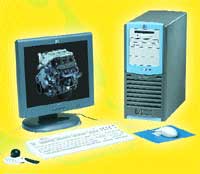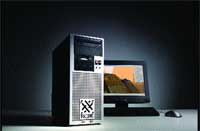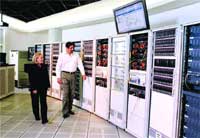|
 |
| HP offers a family of Intel-based Linux workstations, including the x1100 (shown), x2100 and x4000. | It's been just over a decade since Linus Torvalds developed the revolutionary Linux open-source operating system, a derivative of the UNIX OS. Today many have discovered the benefits of using the Linux OS in a wide array of environments, including on a server and on design, effects and compositing workstations. Industry analyst IDC cites Linux as the fastest-growing server environment OS: It forecasts Linux having 38 percent of the market by 2004.
Since the Linux source code is essentially free, in-house technical staffs at post facilities and visual effects studios can modify it themselves. Linux users have the freedom to choose the distribution that suits them best: Red Hat, probably the most popular among post professionals; SuSE; Mandrake; Caldera; Turbolinux or others. Although animation and visual effects require substantial processing horsepower, Linux occupies fewer processing resources and overhead than many other operations systems which can result in significant performance gains. The flexible Linux can run on lower-cost hardware than UNIX or IRIX, and on the most advanced platforms.
As the Linux market share increases, its support by hardware manufacturers and software developers continues to grow - to everyone's advantage.
HP
"I am seeing the major production facilities looking to get out of proprietary hardware and software environments, and moving toward more open systems where they have more control," says Molly Connolly, Hewlett-Packard Co.'s North American marketing manager for digital content creation. "One of their goals is to move to a less expensive yet open hardware model. These studios can buy multiple, Intel-based, open-source Linux systems for a fraction of the cost of their current systems."
Hewlett-Packard (HP) has been involved in the Linux and open-source communities for a number of years, according to Connolly. HP co-developed with Intel the Itanium 64-bit processor which, with Linux, offers customers access to the latest high-performance technologies, open operating system and low price points. "As our HP CEO Carly Fiorina has said, one of the strong points of the company's merger with Compaq means that HP would be more powerfully positioned to lead the march toward open standards and Linux than either company could on its own," states Connolly.
"A year ago people were scratching their heads about Linux," says Connolly. But they're no longer wondering about Linux's role in post production. "I think the economics of the Intel architecture versus traditional UNIX has played a major role in the adoption of Linux. It's very attractive to those with UNIX or IRIX backgrounds, the traditional code warriors. Major studios with a lot of in-house proprietary applications, as well as major software companies like Side Effects, Nothing Real, Softimage and Alias|Wavefront, have included Linux ports for content creation. These companies used HP workstations to successfully port their 32-bit code to Linux, and now we are working with them again to help with their Itanium 64-bit ports."
 |
| Weta Digital used SGI's 330 and 230 Linux OS-based workstation while producing effects shots for The Lord of the Rings: Fellowship of the Rings. The workstations were used for a combination of paint, rotoscoping and compositing. SGI's Jason Danielson is inset. | HP (www.hp.com) offers the media and entertainment market a family of Intel-based Linux workstations - models x1100, x2100 and the top-of-the-line x4000 "Extreme" workstation with dual Intel Xeon processors which are delivered with Red Hat 7.1 preloaded. "Most studios are buying the x4000, which they often use with dual 21-inch monitors," Connolly reports. "They're looking for the ultimate performance desktop."
HP's Linux product line also includes the Netserver lp 1000r, a 1U rack-based server "which affords customers a lot of expandability based on their production needs," says Connolly. "Large studios can populate an entire rack, while a smaller studio may buy a partially-populated rack and add more servers as their business grows."
One key example of the use of HP's Linux products is how the company will provide the computing infrastructure for DreamWorks's next-generation digital studio at its Glendale, CA, facility. This installation will number more than 200 high-end Linux workstations and a 500-processor renderfarm. HP delivered more than 40 HP Netserver lp 1000r systems to DreamWorks for rendering Shrek, and DreamWorks's upcoming Spirit: Stallion of the Cimarron has been created on more than 200 Linux-based workstations and servers.
"We're most proud of how HP has been a front runner in helping customers develop their Linux pipelines," says Connolly. "Long before sales occur, our engineers are working with customers, sharing our expertise in hardware, operating systems and graphics. That speaks volumes about the commitment and resources we're deploying in Linux, and our relationships with our customers and partners."
At NAB: HP will be showing Linux on 32-bit and 64-bit architecture.
SGI
"We began an aggressive Linux development effort 24 months ago," reports Jason Danielson, director of media industries at SGI (www.sgi.com). "We felt that by offering both IRIX and Linux, we would provide better service to our existing customers."
Two blockbuster feature films demonstrate how SGI's traditional IRIX customer base is profiting from the Linux OS. New Zealand's Weta Digital employed both SGI IRIX and Linux-based visual workstations, storage products and servers for production, post and visual effects on its The Lord Of the Rings trilogy. Silicon Graphics 230 Linux workstations were used for paint, rotoscoping and compositing of the three films with SGI 1100 and 1200 Linux servers as the primary rendering resource.
Weta Digital's use of both SGI IRIX and Linux technology "is an excellent example of choosing the right tool for the right job," Danielson says. "It is testimony to how both operating systems can work together seamlessly to produce, render, manage and store powerful visual effects ranging from the photorealistic to the universe of human imagination."
All of PDI/DreamWorks's Shrek was created using SGI desktop systems, mostly SGI 02 workstations. But it was also the first DreamWorks production to embrace Linux technology: 168 SGI 1200 2U dual-processor Linux-based machines comprised the majority of the renderfarm.
More recently, the Silicon Graphics 750 system, a powerful dual-processor workstation, was the first in a series of products scheduled to be introduced by SGI, based on the Itanium processor and Linux.
SGI has discovered that the Linux marketplace is a world apart from SGI's customary high-end IRIX niche. "A lot of companies are providing low-end Linux hardware so, from a business standpoint, it looks more like a Windows commodity marketplace," Danielson notes. "With many vendors selling the same thing, there's little room to differentiate on performance, which is SGI's expertise. Low-end 32-bit Linux workstations and servers are not a great match for us, so we've moved to the 64-bit platform for our server. We're waiting for Intel's 64-bit chip, code-named McKinley, which is right around the corner and will provide better price performance than the current 64-bit Itanium chip."
Danielson acknowledges that while "there's clearly a trend in some studios toward Linux" he doesn't see a rapid mass migration. "For studios with code writers continually adding features and algorithms to proprietary software, the idea of porting code to another OS is a cost to the studio. To move all their proprietary code to Linux is a huge effort they're not geared up to do quickly. It could be a five- or 10-year process."
Danielson believes that progression will not be without "hiccups. Any new technology looks good until it gets into the real world where you discover what its limits are."
The adoption of Linux for Internet servers or rendering makes sense because "you have many servers networked together," Danielson explains. But "the animation and compositing applications that need realtime interactivity are still firmly in SGI's IRIX camp," he says.
"Our long-term vision is that Linux will become an increasingly important part of our product mix," Danielson says. "But we're continuing to find that in high-end visualization and large media management areas IRIX is the only answer. We'll still be selling IRIX 10 years from now."
IBM
IBM's involvement in Linux began over five years ago and spans a number of perspectives. "We're part of the Linux open-source community," says Steve Solazzo, VP of Linux at IBM. "We have a team of 250 software engineers here working on Linux. And we've Linux-enabled our entire portfolio of hardware, software and services. We see Linux as a revenue opportunity for ourselves but, more important, we see Linux as delivering great value to our customers in every industry."
 |
| IBM's eServer xSeries are Intel-based Linux-enabled servers. | Solazzo finds that "every large organization has some Linux going on" right now. "Some are deciding to move to Linux on their normal upgrade cycle. But others see compelling economic reasons to move to Linux, even if their existing equipment is not fully depreciated. They figure the benefits outweigh waiting."
IBM has relationships with a number of Linux distributions. It supports Red Hat worldwide, SuSE which is popular in Europe and increasingly in the US, plus Turbolinux and Caldera. Local relationships include Red Flag in China, Connectiva in Latin America and Mandrake Soft in France. IBM does not ship a Linux distribution with its products but products are Linux-enabled for the four major distributions mentioned above.
Organizations which need Firewalls, Web servers and print and file servers tend to have some Linux operating systems in those functions, Solazzo says. IBM has Linux-enabled, Intel-based eServer xSeries 330 servers for these applications.
The xSeries servers also form renderfarms when configured in Linux clusters. "You can put them in a 'pizza box' format, sliding the one-and-three-quarter-inch-high units into what looks like a baker's rack," Solazzo explains. "A five-foot rack holds maybe 40 servers, all running Linux without licensing costs. They're extremely reliable and terrific at processing high-volume work loads. Users see a three- to four-time price-performance improvement. And IBM software manages the workload across the servers."
IBM also sees a lot of interest in its Intel-based, very high-performance IntelliStation M Pro workstation for animation and post production. "We're beginning to place these systems in larger studios by the hundreds," Solazzo reports. "They're replacing a previous generation of proprietary workstations. For the same amount of money, Linux users are getting a tremendous improvement in production on their workstations. And they're experiencing the inherent benefits of Linux, which is a rock solid, extremely reliable platform."
Last August, IBM announced its Linux Digital Studio Solution, a comprehensive suite of IBM workstations, servers, storage and services designed to support animators, special effects artists and digital media producers. The solution enables a studio, for example, to animate a scene on the IntelliStation M Pro workstation, complete rendering on the shot with the eServer xSeries, store the data on one of several IBM TotalStorage products and technologies, and obtain advice, consulting and support from IBM Global Services. Threshold Entertainment has acquired the IBM Linux Digital Studio Solution. Threshold animated its theatrical short Edward Fudwupper Fibbed Big entirely on the IntelliStation M Pro workstation.
Solazzo sees "more, more, more" Linux ahead. "With each passing year the value of Linux becomes more significant for our customers," he declares.
At NAB: IBM will unveil its Digital Content Creation Solution, which is designed to take advantage of Linux functionalities to facilitate animation, digital content creation and more efficient rendering. Threshold Digital Research Labs and The Savannah College of Art & Design will be displaying animation designed with IBM's Digital Content Creation offerings.
BOXX TECHNOLOGIES
"Linux didn't have open GL capabilities and was pretty [clunky] when it started," notes Todd Bryant, chief technical officer at Boxx Technologies (www.boxxtech.com). "But as it started maturing, and other enhancements came in, we chose to offer it in our product line."
Boxx's RenderBoxx, a high-speed rendering solution for digital content and powerful 3DBoxx workstations, currently support the Red Hat Linux distribution although Bryant says "we'll support whatever distribution clients want - SuSE, Mandrake, some customers have their own."
Linux remains most popular with clients for rendering. "Rendering is the primary bottleneck. It can be the most processor- and time-intensive task in the production pipeline, so naturally it is at the top of the list for everyone, whether they're running Linux or not," says Bryant. "For example, if you have SGI IRIX boxes producing the creative in the front end of the production workflow, they will easily interface with the Linux rendering systems for an operating system that's inexpensive and fairly easy to maintain on the back end."
RenderBoxx was developed about five years ago and now runs on Windows 2000 and XP, and Linux. "It was originally built for studios with a need for a back-end renderfarm with high-rack density and the fastest processors available. But we have discovered that it's also popular in boutique studios that need to offload the rendering from their production workstations. Now we're up to AMD Athlon MP 2000+ dual processor machines," Bryant explains.
 |
| Boxx's 3DBoxx features dual AMD processors. A dual-Xeon version is also in the works. | 3D workstations have been one of Boxx's flagship products for the past half-dozen years. In March, the company introduced a dual 2000+ AMD 3DBoxx workstation with Nvidia Quadro4 technology that is Windows and Linux compatible; a dual Xeon version will be unveiled at NAB.
Bryant sees Linux as a good fit for post facilities with in-house technical staffs who already understand UNIX. "If a large post house is heavily invested in the UNIX OS, their tech support team can easily incorporate Linux systems into their production environment without experiencing any lag in productivity. Newer or smaller studios, where a tech support team isn't feasible or the systems administrators aren't familiar with UNIX, tend to stick with NT because it's what they're used to. They may consider adding Linux to their production workflow, but I don't expect that to happen until Linux is a more streamlined OS that requires minimal technical support."
While the market for Linux continues to grow, Bryant doesn't believe Linux will gain critical mass overnight. "In 2001, approximately 90 percent of our customers wanted Windows 2000 or NT, so naturally we will continue to develop and support Windows," he reports. "But we will also continue to develop and optimize our systems for Linux to meet the needs of our customers like Digital Domain and Cinesite - large production facilities with onsite technical support teams - who rely on the union of UNIX and Linux in the production environment. Perhaps eventually that dynamic will change and Linux will become a standard in the post production environment, but for now at least, it's still a lopsided race."
At NAB: "We'll release a dual 2.2 Intel Xeon RenderBoxx with a 1U form factor, interleaved DDR memory for fast memory-to-CPU access and gigabit Ethernet on board," says Bryant.
COMPAQ
"We've been doing Linux for more than 10 years. We have a Linux history here," declares Judy Chavis, director of the Compaq Corporate Linux Program office.
Early on, Compaq (www.compaq.com) pioneered with Linus Torvalds and other kernel developers on "the guts of the operating system," Chavis says. For the past three-and-a-half years the company has been shipping Linux-enabled systems.
Compaq's partnerships with key Linux distribution vendors assure better integration and support. The company works principally with Red Hat and SuSE to continually test, verify and certify Linux with various platforms and options, as well as works with regional suppliers of Linux distributions and services.
Compaq's depth and experience base in UNIX engineering development supports both 32- and 64-bit Linux architectures. Teams of engineers develop, test and maintain software for technologies found on Compaq platforms.
Compaq offers a wide range of systems for Linux, including industry-standard Intel processor-based ProLiant servers, Alpha processor platforms, single- or multiple-processor workstations and StorageWorks storage systems. Compaq has even ported Linux to its iPAQ Pocket PC. "People can come to Compaq for support of the entire solution," Chavis reports.
Compaq's Linux strategy has been heavily server-centric. Compaq is the number-one PC server platform for Linux today with 26 percent market share according to IDC. The ProLiant is the server of choice for edge Web servers. Certain ProLiant servers can be ordered from Compaq with Red Hat preinstalled; SuSE is also available in Europe preinstalled on selected ProLiant servers.
"People initially moved to Linux for price and performance," Chavis notes. About six to nine months ago customers who were deploying Linux in the server environment started asking themselves if the OS held promise for other applications.
"It's a given that Linux works for renderfarms, compute farms and service providers, like Web hosts, because it's a UNIX kind of system," Chavis says. "But where does it go next? Can it run the business? It's doing that today."
DELL
With the business model of every computer built to order, Dell (www.dell.com) was an early provider of Linux-enabled Precision Workstations to meet customers' needs in the post production environment.
 |
| A Compaq server room: The company's Linux strategy is heavily server-centric. |
"We're serious about the digital content creation [DCC] space," says Joe Curley, worldwide manager for Dell Precision Workstation marketing. "If you're serious about DCC, you're going to have a Linux offering. "Is the issue in the DCC space the underlying operating system or the application people are using to craft and create?" he continues. "It's typically the latter. So it's up to us to make sure the application runs fast, reliably and meets or exceeds customers' expectations."
To do that, Dell offers the latest release of Red Hat Linux 7.2 on its Precision Workstation and PowerEdge Server lines. The Precision 340 Workstation features the fastest Intel Pentium 4 processor available, while the Precision 530 has dual Xeon processors in a highly-scalable workstation.
Because every Dell computer is customized for its user, "if you've specked out a task, we can do the engineering around your specific platform needs and deliver a system highly optimized for your project," Curley explains. "One of Dell's strengths is listening to our customers. We don't say, 'Here's the way you have to do your business.' If an artist working with a big studio needs to build a dual-processor Xeon system with a certain amount of storage and Nvidia technology on Linux, he can do that through our Web site. It's something we do everyday."
Larger complements of Precision Workstations may also be configured for post facilities and studios. CGI for the first Matrix feature was generated on Dell Precision Workstations running the BSD Linux distribution. Similar systems were also used on the visual effects for Hollowman. And the winner and semifinalists in HBO's Project Greenlight each received a package, including a Dell Precision Workstation.
"Dell Precision and PowerEdge offer special technical support queues trained to support the need of technical users," Curley points out. "In addition to the support Dell provides all customers, Dell utilizes a dedicated support team which is trained to support the hardware, application and software needs of Linux users and is also partnered with LinuxCare and Red Hat for in-depth support. Dell continues to develop drivers and provide those as open source into the Linux development community."
Curley sees people moving to Linux from two market segments. One group "is coming from a closed, proprietary architecture, from expensive UNIX workstations and migrating to a less costly, open structure," he says. The rest are "expert users who are developing ground-up on Linux. For them, Linux is a tool to enable a very particular solution." |